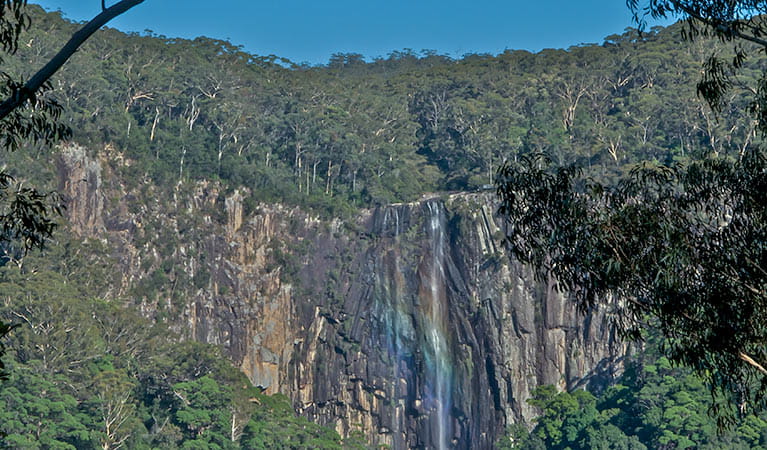Whian Whian State Conservation Area
Overview
In Whian Whian State Conservation Area, north of Lismore, you’ll find cycling, hiking and horse riding trails, as well as waterfalls and creeks for swimming and fishing.
Read more about Whian Whian State Conservation Area
Just to the north of Lismore, Whian Whian State Conservation Area was formed to protect an area that surrounds Nightcap National Park. This charming area and its surrounds are chock-full of fantastic, fun things to do outdoors.
It’s a great spot from which to enjoy some of the day walks in the area, take a picnic, or go on a mountain bike ride. For longer adventures, you can base yourself at the tranquil forest setting at Rummery Park campground. This small but well-equipped campground is popular with overnight bushwalkers undertaking the Historic Nightcap track from Mount Nardi, some 18km to the west.
There are plenty of trails in Whian Whian and Nightcap, where you can hike, cycle, or even horse ride among the ancient towering kauri, bunya and hoop pines. Native Australian animals such as goannas, kookaburras and brushtail possums will accompany your adventures, as well as threatened species such as the spotted-tailed quoll, koalas and Albert’s lyrebird.
Local alerts
For the latest updates on fires, closures and other alerts in this area, see https://www.nationalparks.nsw.gov.au/visit-a-park/parks/whian-whian-state-conservation-area/local-alerts
Contact
- in the North Coast region
Whian Whian State Conservation Area is always open but may have to close at times due to poor weather.
-
-
Alstonville office
02 6627 0200
Contact hours: Monday to Friday, 8:30am to 4:30pm - Russelton Industrial Estate, 7 Northcott Crescent, Alstonville NSW 2477
-
Email: npws.richmondriver@environment.nsw.gov.au
-
Alstonville office
Visitor info
All the practical information you need to know about Whian Whian State Conservation Area.
Map
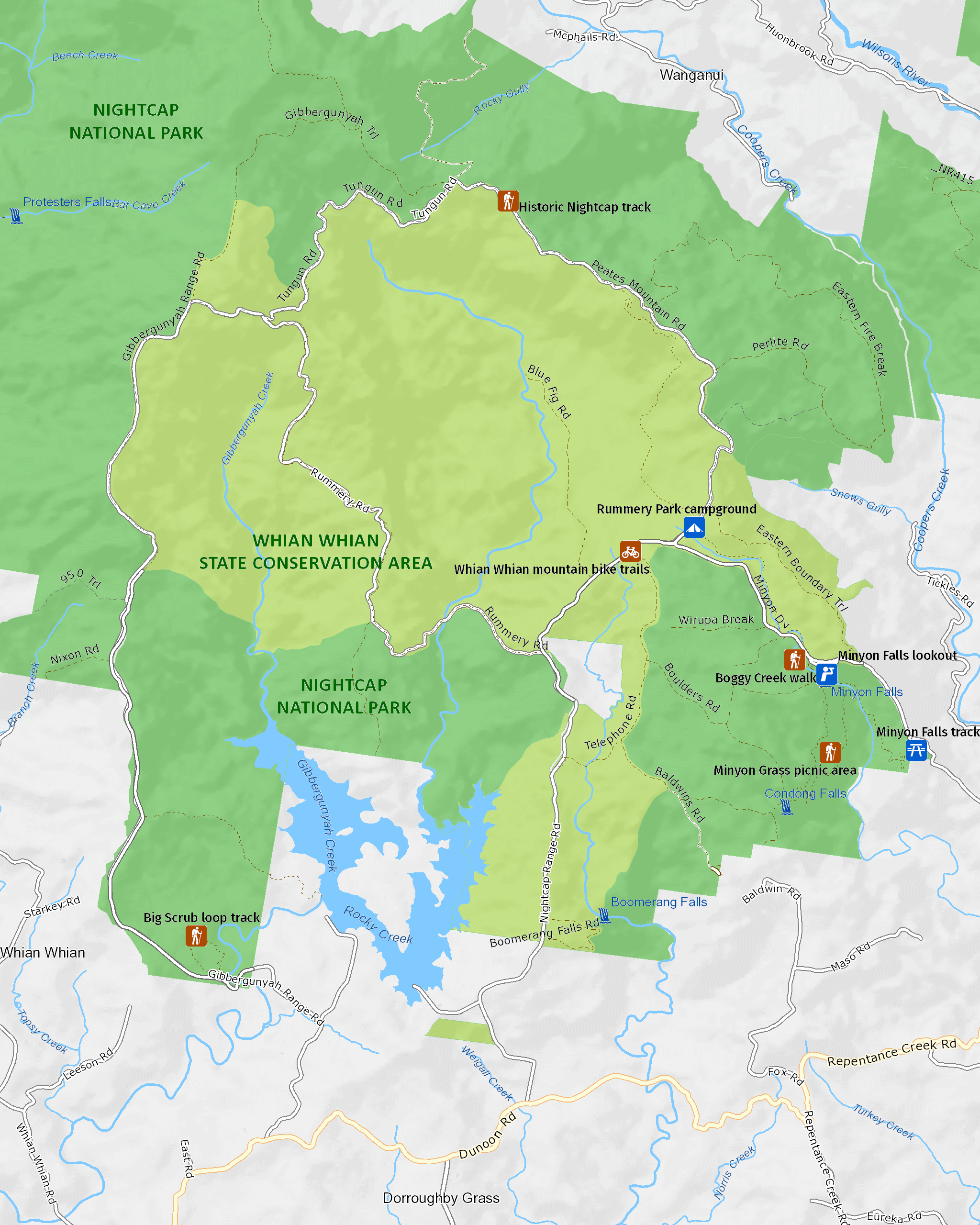
Map legend

Getting there and parking
Get driving directions
From the north (Brisbane):
- Travelling on the Pacific Highway exit south of Byron Bay, at the top of the hill, turn right into Coolamon Scenic Drive. Follow this winding road through the village of Coorabell.
- Continue, then turn right to the village of Federal. From Federal, continue north along Federal Road, then turn left into Repentance Creek Road.
- Head west along this road and across the Byangerry Creek crossing and continue. Just over the Coopers Creek crossing, turn right into Upper Coopers Creek Road, then left into Minyon Falls Road and follow through to the park entrance.
From Lismore:
- Take Dunoon Road out of north Lismore and go through the villages of Modanville, then Dunoon, then Doroughby. Just past Dorroughby Hall, turn left into Nightcap Range Road and follow right through to the SCA entrance.
- Continue until you reach the Peates Mountain Road intersection (turn left if you want to go to Rummery Park campground) or continue straight through to Minyon Falls within the Nightcap National Park (Minyon Drive).
From Bangalow:
- Travel towards Lismore on the Bangalow-Lismore Road until you reach the village of Clunes.
- Turn right into James Gibson Road, then right into Mackie Road, then right onto Rosebank Road.
- Through Rosebank village, follow Repentance Creek Road, then turn left into Upper Coopers Creek Road, then left again into Minyon Falls Road. Continue along this road then into the Nightcap National Park entrance on Minyon Drive. Follow park signs from there.
Parking
- Rummery Park campground See on map
- Whian Whian mountain biking trails See on map
By bike
Check out the Bicycle information for NSW website for more information
By public transport
There is no public transport to Whian Whian State Conservation Area.
Best times to visit
There are lots of great things waiting for you in Whian Whian State Conservation Area. Here are some of the highlights.
Autumn
The cooler months are great for enjoying some of the longer bushwalks available in both Whian Whian and the adjoining Nightcap National Park - Autumn/winter .
Spring
Bushwalking when many plant species are in bloom, such as bottlebrush, wattle and tea tree species along the creeks. Swimming in the Boggy Creek along the Boggy Creek walk The Freedom Marathon is an annual event held in spring .
Summer
When the weather heats up, swimming in Boggy Creek is a popular way to cool off.
Weather, temperature and rainfall
Summer temperature
Average
28°C and 28°C
Highest recorded
40°C
Winter temperature
Average
8°C and 18°C
Lowest recorded
-0.6°C
Rainfall
Wettest month
February
Driest month
September
The area’s highest recorded rainfall in one day
430.5mm
Facilities
Toilets
Picnic tables
Barbecue facilities
Drinking water
Maps and downloads
Prohibited
Pets
Pets and domestic animals (other than certified assistance animals) are not permitted. Find out which regional parks allow dog walking and see the pets in parks policy for more information.
Smoking
NSW national parks are no smoking areas.
Nearby towns
Mullumbimby (23 km)
Mullumbimby sits on the Brunswick River and is overshadowed by subtropical hills.
Bangalow (26 km)
Bangalow is a relaxed but stylish village close to Byron Bay. It's set in lush green hills near the coast.
Lismore (35 km)
Lismore is a major North Coast commercial, cultural and administrative centre. It's set in undulating country on the north arm of the Richmond River.
Learn more
Whian Whian State Conservation Area is a special place. Here are just some of the reasons why:
Historic heritage of timber-getters
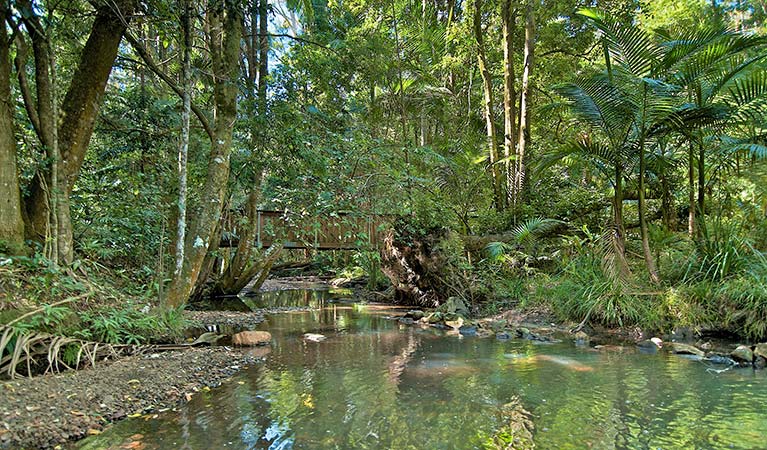
Lured by the opportunity of employment in difficult times, timber-getters began logging in the Whian Whian area in the 1830s for red cedar, a particularly sought after timber. In 1871, surveyors identified a track over Nightcap Range to link Lismore with Murwillumbah. This allowed cedar-getters access to previously isolated expanses of forest. The Rummery Park campground was originally a forestry camp, and its use dates back to the 1930s. The inter-war period was the most active period for forestry use of the campground. Peates Mountain Road (now part of the Nightcap track) was built during the depression of the 1920s and 1930s. Sleeper-cutters who claimed timber unsuitable for milling, camped nearby on the other side of Boggy Creek at Rummery Park.
- Historic Nightcap walking track Historic Nightcap walking track leads through World Heritage-listed rainforest, offering scenic views across Nightcap National Park and Whian Whian State Conservation Area, near Byron Bay.
4,000 years of Aboriginal culture
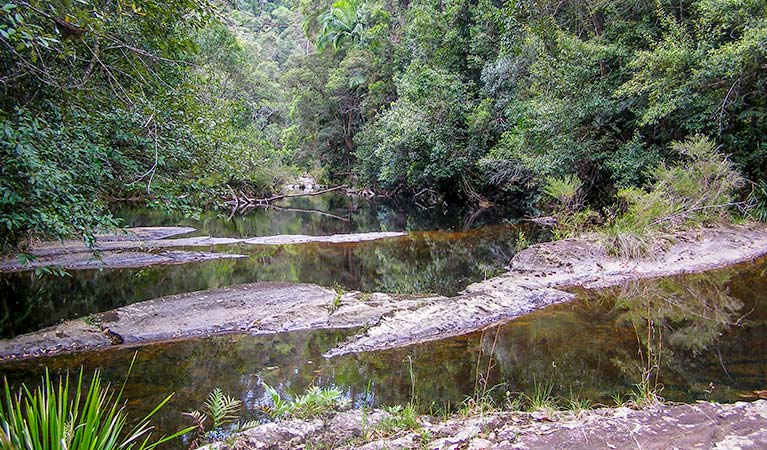
The conservation area is located within the traditional lands of the Widjabal clan of the Bundjalung Nation. Evidence from recorded sites suggests Aboriginal use of the Nightcap Range for at least the last 4,000 years. The area has intrinsic cultural values to the Widjabal People and the land has significant connections with other recorded sites in the adjacent Nightcap National Park.
World heritage worthy
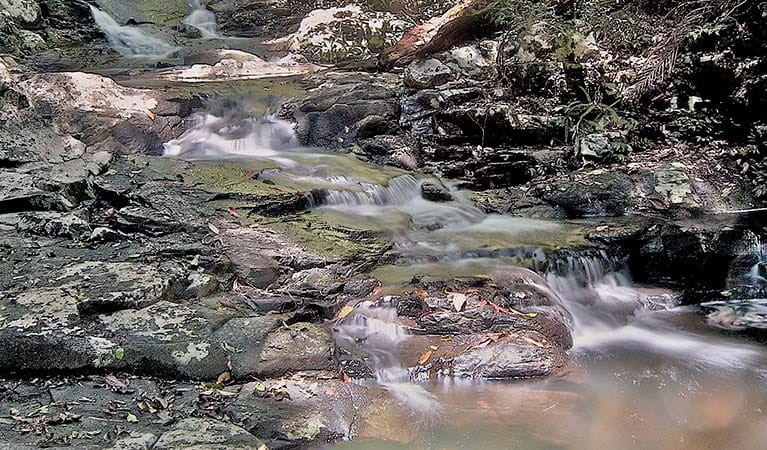
The conservation area has similar vegetation and natural heritage values as those found in the adjoining Nightcap National Park, one of the 50 reserves in northeast NSW and southeast Queensland that make up World Heritage Central Eastern Rainforest Reserves Australia.
- Whian Whian mountain biking trails Suitable for bushwalkers, cyclists and horseriders, Whian Whian mountain biking trails near Byron Bay offer stunning views of waterfalls and rainforest.
Walk with the animals
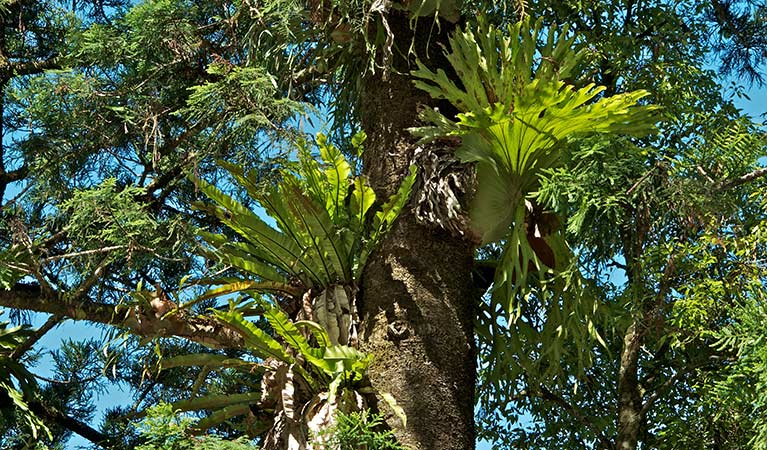
There’s also an incredible variety of native animal species thriving in these rainforests – over 270 native species, around 50 of which are listed as threatened, including the spotted tailed quoll. Koalas and Albert’s lyrebird, with its distinctive calls and mimicking echoes, can often be heard through the forest in the cooler months.
- Whian Whian mountain biking trails Suitable for bushwalkers, cyclists and horseriders, Whian Whian mountain biking trails near Byron Bay offer stunning views of waterfalls and rainforest.
Plant life galore
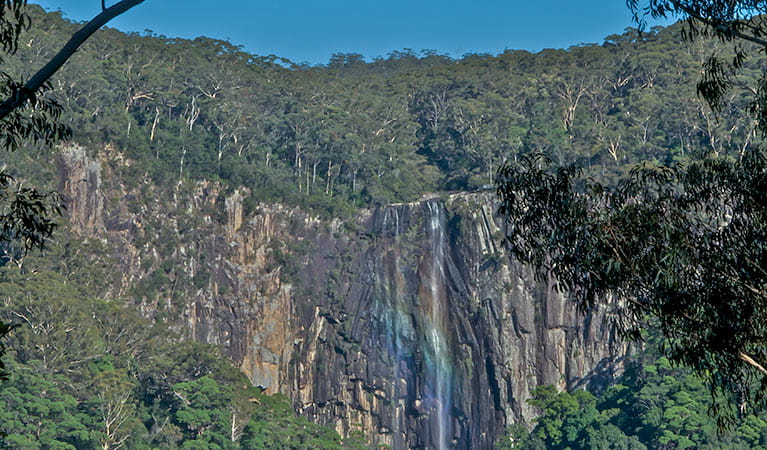
An astounding 520 plant species have been recorded here – making it an incredibly diverse place when it comes to vegetation. There are 10 broad ecosystems, including subtropical and warm temperate rainforests and various types of wet sclerophyll forest.
- Boggy Creek walk Boggy Creek walk in Whian Whian State Conservation Area takes you through blackbutt forest and along the beautiful Boggy Creek to Minyon Falls. You can swim in the inviting pools along the creek.
- Historic Nightcap walking track Historic Nightcap walking track leads through World Heritage-listed rainforest, offering scenic views across Nightcap National Park and Whian Whian State Conservation Area, near Byron Bay.
Plants and animals protected in this park
Animals
-
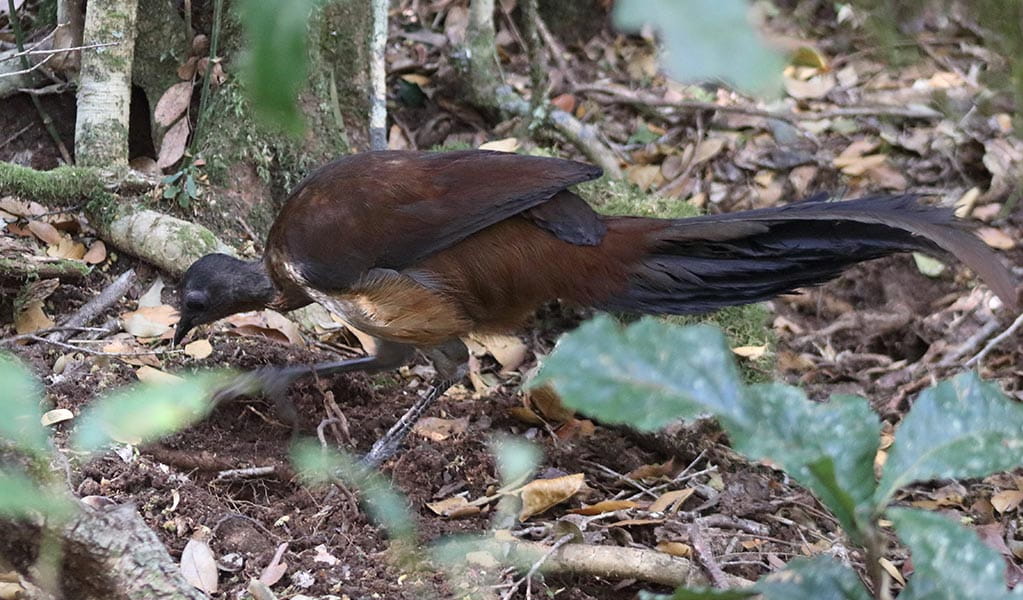
Albert's lyrebird (Menura alberti)
The Albert’s lyrebird is much rarer than the superb lyrebird. Distinguished by its richer brown plumage and less elaborate tail feathers, it’s protected as a threatened species in NSW.
-
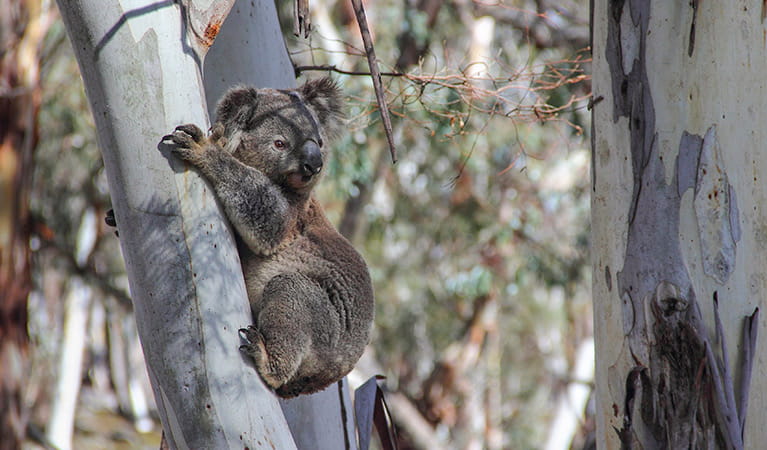
Koala (Phascolarctos cinereus)
One of the most renowned Australian animals, the tree-dwelling marsupial koala can be found in gum tree forests and woodlands across eastern NSW, Victoria and Queensland, as well as in isolated regions in South Australia. With a vice-like grip, this perhaps most iconic but endangered Australian animal lives in tall eucalypts within a home range of several hectares.
-
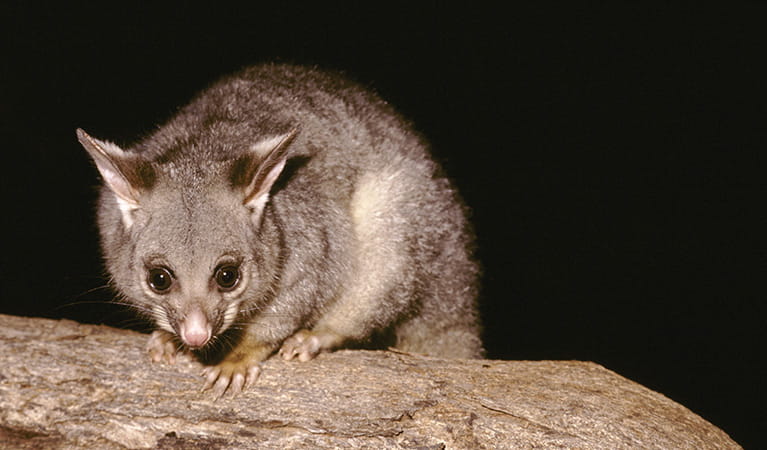
Common brushtail possum (Trichosurus vulpecula)
One of the most widespread of Australian tree-dwelling marsupials, the common brushtail possum is found across most of NSW in woodlands, rainforests and urban areas. With strong claws, a prehensile tail and opposable digits, these native Australian animals are well-adapted for life amongst the trees.
-
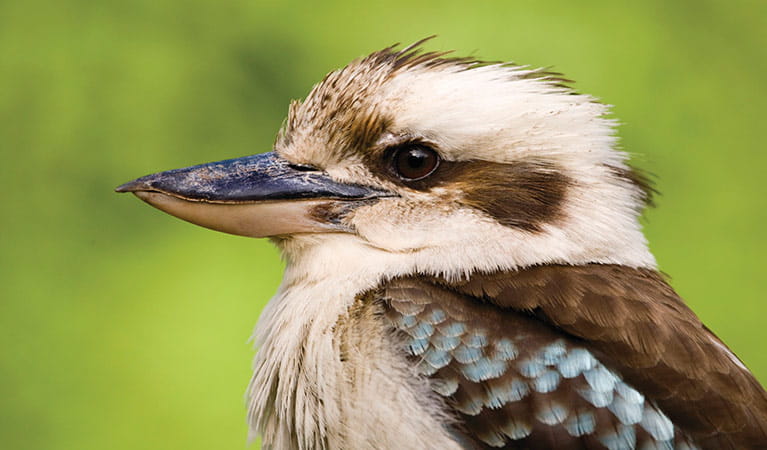
Kookaburra (Dacelo novaeguineae)
Of the 2 species of kookaburra found in Australia, the laughing kookaburra is the best-known and the largest of the native kingfishers. With its distinctive riotous call, the laughing kookaburra is commonly heard in open woodlands and forests throughout NSW national parks, making these ideal spots for bird watching.
Education resources (1)
What we're doing
Whian Whian State Conservation Area has management strategies in place to protect and conserve the values of this park. Visit the OEH website for detailed park and fire management documents.

